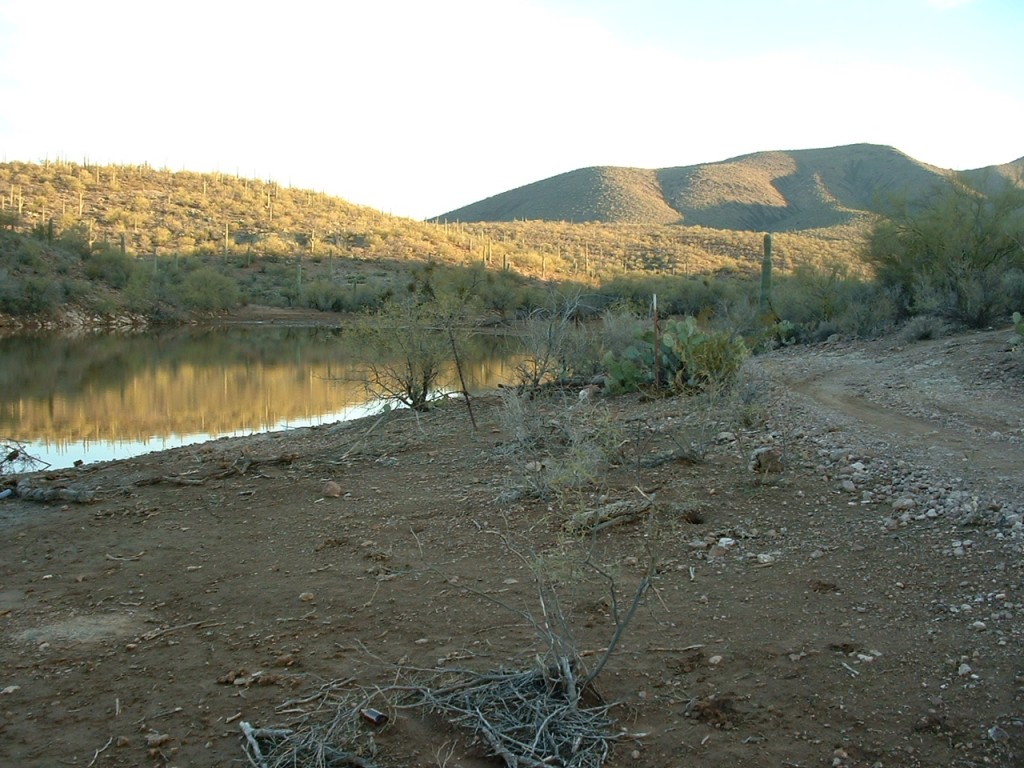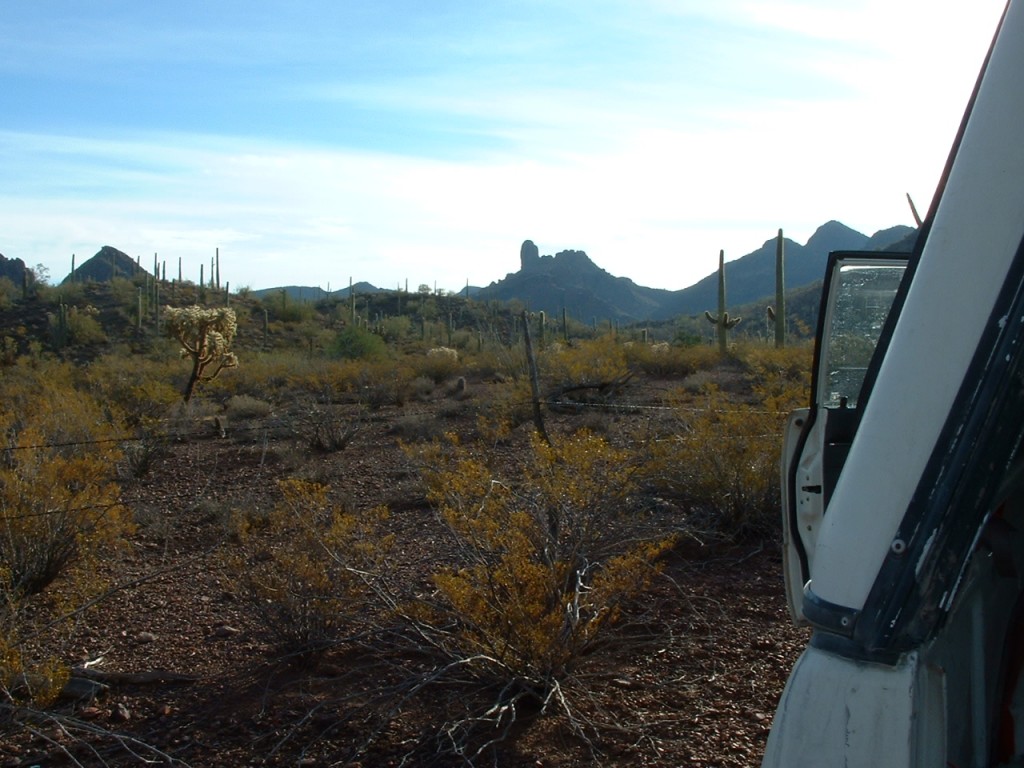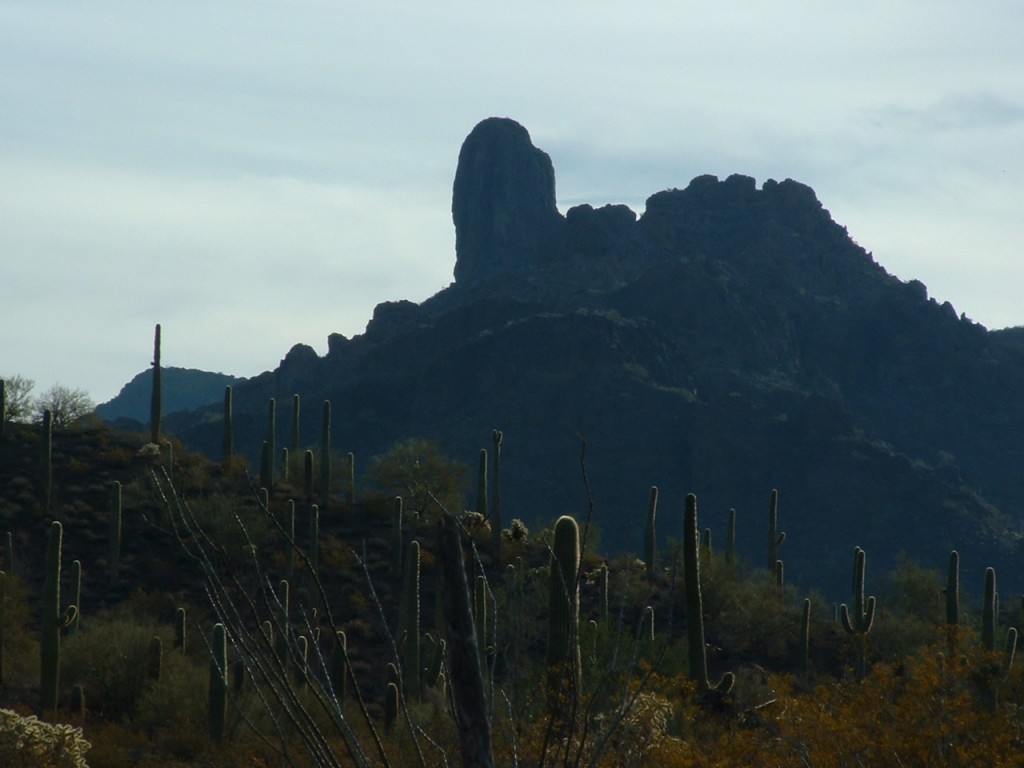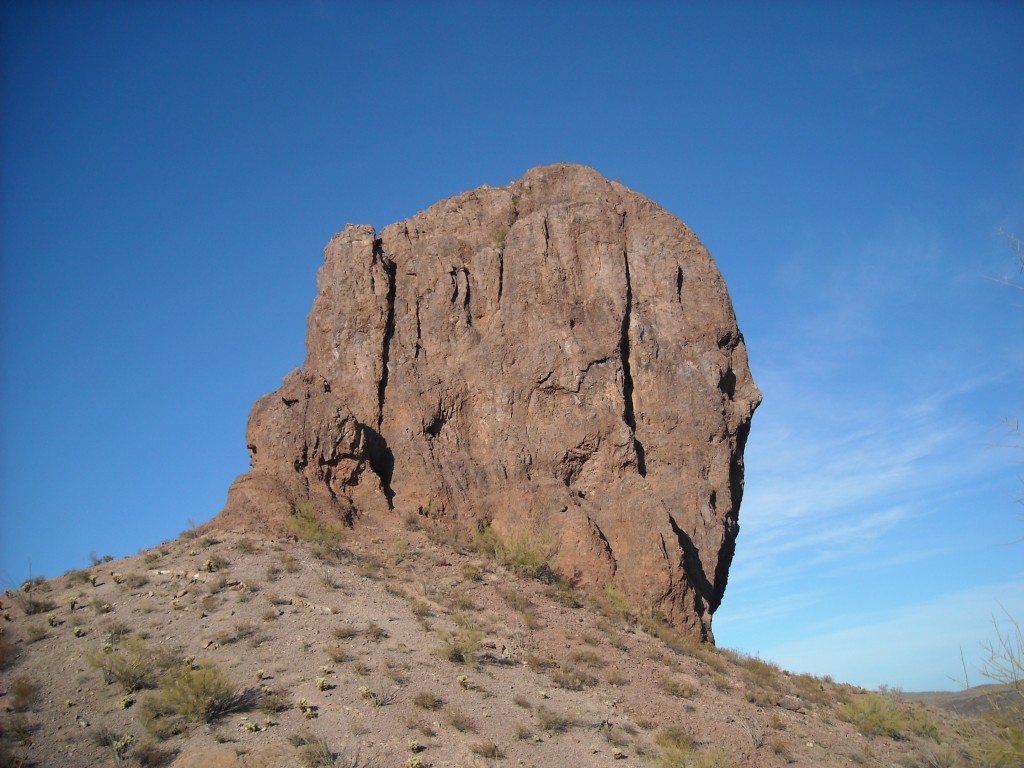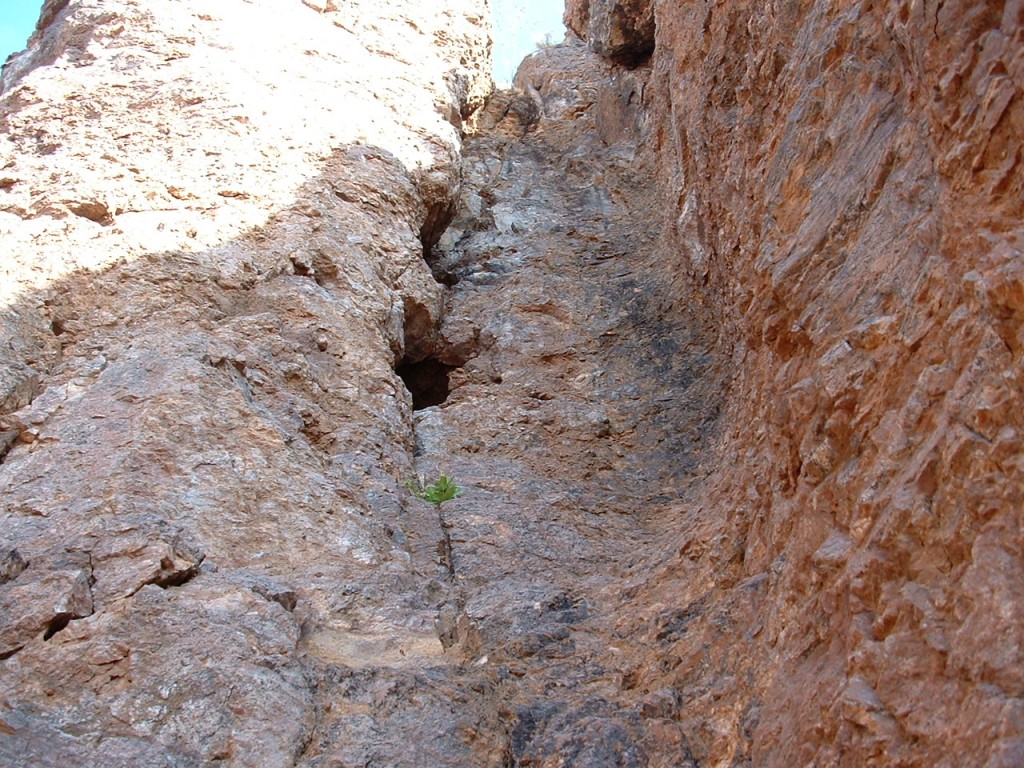You know those little cars that you see in the circus, the type out of which an endless number of clowns will climb, to the astonishment of everyone – I think they’re actually called “clown cars”. It was as if we were seeing one of those. It was nearly 5:00 PM, the sun was going down behind the nearby hills and we were driving hard to get into a less dangerous area before it became completely dark. That’s when we saw it – a hundred yards ahead, coming straight at us – a white Ford pickup with an open bed. Four men were squeezed into the cab – probably the “coyote” and his highest-paying charges. Men were standing in the bed of the truck – lots of men. Men were hanging off the sides of the bed and off the tailgate. Men were standing on the bumper. Hispanic men, fairly young, in their 20s and 30s. In all, 25 men in one vehicle! It was so astonishing to see. We wouldn’t have believed it if we hadn’t seen it with our own eyes.
I told Andy to roll up his window and lock his door while I did the same. Not wanting to provoke anyone and risk being attacked, we gave them a friendly smile and a wave as we passed each other. Some of them nervously waved back. A group as large as theirs could have easily overwhelmed us and taken our vehicle. Ours was a four-wheel-drive with an enclosed shell, theirs was not. Our vehicle could have been a big help to them. They were undocumented immigrants sneaking into the U.S. They were 100 road miles inside the country and had eluded capture up until now. It was amazing how they had gotten that far. Not only had they eluded many Border Patrol agents, but in order to get to where we met them, they would have had to do some very hard driving.
There were only two ways to drive to where they were. One was to come north from the village of Hickiwan through a sea of mud, a remnant of the fierce rainstorms from a week earlier. We ourselves had barely made it, using four-wheel-drive for miles. We had passed a pickup truck, abandoned, mired up to its axles in thick mud. I can’t imagine how they would have done it without getting stuck. Of course, as Andy mentioned, they had one advantage – they could have bodily lifted the truck up and over a bad spot!
The only other way to get to where we met them was to come from the west, up into the Sauceda Mountains, via the gas pipeline road. That was the road from hell. Miles of it were very steep, covered in rough rock and very daunting. We descended that way, and there were many spots where it was so bone-jarring that it made you cry out loud. One time we hit such a bad spot that I was thrown up and over, hitting my head on the door frame and seeing stars. And what we were doing was much easier, descending – they would have had to have gone uphill all the way. That road is now so bad that it could loosen the fillings in your teeth.
Hours later, we stopped at a gas station in Sells. I spoke to four Border Patrol agents there and told them what we had seen hours earlier. They said there was no chance of those guys getting through. There were remote sensors in that area along the roads, alerting the Border Patrol to any passing vehicles. Also, Borstar was operating in that area that night. They are an elite group of Border Patrol agents who can track and apprehend just about anyone. But to my mind, the biggest obstacle those men faced is the route itself. They had another 30 miles to travel in order to reach a highway, and to do that they would have to travel through many miles of patrolled military reservation. I only know one person who has ever driven that entire route – Mark Adrian, from San Diego – who says that it included some of the most hair-raising four-wheel-drive road he has ever travelled in his life. So, I would venture to say that those guys will not succeed in their quest to reach the Promised Land, not this time anyway.
I had been to Tom Thumb three times in the past. Twice with Brian to attempt it, once with Mike to check out routes. Never did make it to the top. It is an odd mountain. Just under one air mile from the road, it is only visible from a few remote spots. It cannot be seen from any highway, adding to its mystique. Although it is a named peak on the USGS topo map, it is way off anybody’s radar. It rises about 320 feet from its highest saddle and is very dramatic to look at – a sheer pillar of rock, overhanging most of its base.
Less than a mile from the Tohono O’odham Indian Reservation, it sits on the Barry M. Goldwater Bombing Range, but in a quiet area which rarely sees any military activity. Years ago, Mark Adrian had walked over to it and circumambulated it, trying to find a way up. He spent little time there, instead electing to head farther cross-country to the northeast to climb Donkey Benchmark. His visit there was the only knowledge I had of Tom Thumb.
So, fast-forward to January 30, 2010. Andy Bates had driven down from Phoenix and we had then driven to the peak in my truck. It had taken about 3 hours to get there from Tucson. A lot of hard back-road driving. We left the truck at 10:00 AM with a lot of climbing gear.
An hour later, we were at the base of the rock. A cool wind was blowing, and our route was partly in the shade. We sorted out our gear and roped up. I put Andy on belay at about 11:40 AM and away he went. The next picture you see shows the south side of Tom Thumb from 500′ away. This next section of the write-up is in Andy’s words:
“We started our climb by easily scrambling up the prominent gully on the SW side of the peak for about 15′.
At a distance, along our hike up to the base of the peak, we had observed that this gully, while steep initially, appeared to reach another deep, but less inclined gully about 75′ up, just where a small bush was growing perched at the precipice. We decided upon that bush as our goal, for we suspected the remainder of the route would go, if we could just make it there. Once we got our gear settled, our harnesses on, and the rope ready, I took the lead and began climbing up some “easy 5th” rock in this gully. Just below a large ledge, 15-18′ up from our rope-up spot, is a small opening in the rock which we called “the cave”.
Barely a foot wide or deep, this feature did not do anything but create a small pocket devoid of holds. Here, and throughout this climb, we encountered what appeared to be decent hand or footholds, but which would easily break off with a slight bit of pressure in the wrong direction. I spent a good deal of time testing everything for security prior to weighting anything. I found that a quick stem out to the right wall proved helpful in overcoming the lip of this first ledge without having to rely on loose-looking handholds. Just below the cave I found a shallow crack to fit a small hex in for my 1st piece of protection. On top of the first ledge, there is plenty of space to move around. The direct route up this “gully” immediately begins to move up a very vertical corner and climbs another 25′ or so until it begins to become slightly overhanging. If one were to climb to that point, the next logical step would be to try to traverse over and up to the right 6-8′ and into a slanted, narrow chute. Although I couldn’t clearly tell from below, I had a hunch that once in the chute, something would work out at that point. There appeared to be many holds scattered along the way, but as I quickly discovered, virtually nothing to use in protecting the lead. I only climbed up this route a few feet before stopping and returning to the ledge. Instead, I began to inspect the right-hand wall which, while providing less features to climb with, was not quite as vertical and offered an excellent groove where I was able to place a medium-sized hex in a very secure manner. The problem with this route was that it didn’t appear to go anywhere. With the help of this 2nd placement, I was able to protect the short 10′ of mid to upper Class 5 climbing up the right hand wall that led into an overhanging alcove. This turned out to be the actual crux of the climb in difficulty, but certainly not fear. My feet on a small slanted ledge, I could stand up here, albeit in a crouched-over sort of way.
The alcove offered no protection that I could see and I never felt comfortable for the couple of minutes I hung out at this spot. My last (2nd) piece was now closer to the last ledge than I was to it. I very quickly decided that my initial hope of climbing back into the main gully and directly up into the chute looked very hard, and still unprotected. However, upon reaching this alcove, another option had become available. I could now climb out of the gully to the right and out onto a tiny arête. Doing this required leaving the relative safety of the alcove and stepping onto some small boulders which shifted slightly under my weight. I now could look up and see another small ledge 10-12′ above. I could not climb directly up to this ledge as the only good-looking handhold felt like it was just about to break off. Instead I crossed in front of this arête and over into another corner farther to the right. In doing this I had to step over a large and exceptionally loose flake, literally just barely resting on the side of the cliff face. In addition to being the most exposed section of the climb, this part was also the most precarious, as one push in the wrong direction would send these flakes of rock down the side of the peak. I was very pleased when I found a crack large enough to fit a small wired nut (3rd piece), just before finishing this very short traverse. However, once in the shallow corner on the other side of the flake, I realized that the placement was completely worthless as the crack itself marked another separation of flake to cliff face. It was here the questions started coming to me. Where am I?
Wait, why am I here again? Figuring it was easier to keep going up, I faced out from the rock face and slowly pushed upwards in this corner until I could safely climb onto the next ledge. Facing out seemed to help not put weight on the wrong rocks. Once on this ledge, I was immediately next to that desirable chute I could see from below. I quickly found a couple of better cracks for additional wired nuts to fit, then dropped a couple of feet into the body-width chute. At this point I started breathing easier as this was a very secure position. I climbed up the chute a good ten feet and placed a medium cam in a 2 inch crack (2nd-most-secure placement). Looking back to my left, I could see the small bush, marking the entrance to the deep, less inclined gully. A cautious traverse on a foot-wide ledge brought me into this gully, which I followed upwards for another 30′ or so. A yell from the Desert Mountaineer below let me know the half-way mark on the 70-meter rope was just passing his hand. Time’s up, I needed to find an anchor now. Luckily a large boulder sat directly next to the top of this gully with just enough of a gap to wrap a 10′ sling around. This boulder was very secure. We unthreaded the rope from the protection used on the climb up, and reset it so that the DM would have a direct line to climb. The route would have to be cleaned on the descent.”
Here, the write-up resumes in my words, from the time Andy started climbing.
I could see Andy climb for a while right above me, but when he climbed to the right and out of the gully, looking for easier ground, I soon lost sight of him. He reappeared and said he was at a big flake which was very loose.
He was taking a long time to put in some good protection. After a while, he climbed up higher on the face and disappeared again. Some time later, I saw him straight above – he had regained the gully directly above me in which he had started the climb. He placed some protection in a chute, then moved out to the left above the steepest part of the gully, continuing up and out of sight. Quite a while passed before he told me that he had set up a good anchor and was able to belay me up. It was good to hear his voice again, after so much time had passed with no conversation, with me down below and him out of sight higher up. He was about 75 vertical feet above me. However, when he called down to me to say that he had good news and bad news, my heart sank. Andy is a pretty upbeat kind of guy, and he always tries to be encouraging when he’s leading a climb with me. He tells it like it is, though, so when he said he had some bad news, I knew I was in for trouble.
Stay tuned for the conclusion of this story, in “Tom Thumb Part 2”.
Please visit our Facebook page at: https://www.facebook.com/pages/Desert-Mountaineer/192730747542690

